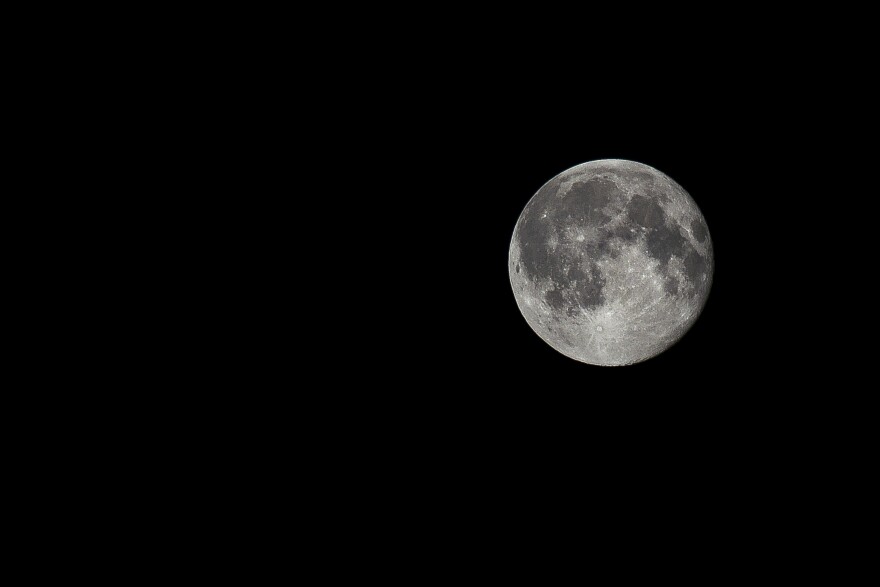One day late last autumn, I strode in the house, flung off my coat and hollered, "Riely, do we know what time the moon rises?"
"Look on the mirror," he hollered back. We weren't mad-hollering; we were just excited. We'd hatched a plan to drive up to Lake Michigan for dinner at the Roadhouse, and then watch the Harvest Moon rise as we rode home.
The post-it note on the mirror read 7:19. Working backward, as is his wont, he proposed a well-timed schedule. I proposed, as is my wont, that we take the prettiest route possible.
"And let's go down the darkest roads for the trip home," I said, and Riely agreed.
This is what it's like when you know the territory. It's the polar opposite of travel to new and exotic destinations, but it too has marvels to behold.
Between our city limits and our inland sea lies mostly farmland. On the Indiana side of the state line it's all big flat fields of corn and soybeans. All of it. Once across the border into Michigan, you'll find yourself, as we did, winding through a hilly terrain covered with orchards and vineyards and fields with pumpkin or wheat or small herds of cattle, all interspersed with woods and more pocket-sized fields of corn and soy.
By the day of that last Harvest Moon, we saw the grain had mostly been taken in, the fruit and the squash all collected. Tough green walnuts lay on the road, unwanted. Only the soybeans remained to be harvested.
Really, what could be more prosaic than a plain old soy field? But, under the low sun at the end of that autumn day, we saw again its 'serviceable' brown transformed, awash with pinks and grays and tans so warm they glowed. We didn't stop for photos. You can't really photograph it. We just murmured our appreciation as we drove past that ephemeral color.
The charm of something as humble as the beauty hidden in soybeans awaiting harvest lies in part in its cyclical nature. For millennia, humans relied on our awareness of such cycles to organize our activity. But now we live within this forest of infrastructure that separates us from nature and replaces it with technology. Best example of what I'm talking about: do you check the weather by opening your door and walking outside - or do you click on the weather app on your cellphone?
Well, after dinner, as planned, at 7:15 we were homeward bound, headed east on Warren Woods Road.
Riely drove and I kept my eyes on the horizon in front of us. A few minutes of silent anticipation and, "There it is!" I whispered.
A huge orange sphere was just visible through the woods. The whole landscape became art. The sky, still turquoise in the west behind us, was dark blue-gray to the east where the moon was slowly rising. Those walnut trees, always the first to lose their leaves, framed it within their naked limbs as it climbed.
Then, "What's that?" Riely said, as two, no four huge headlights suddenly swung toward us from the side.
"It's a harvester!" I cried. "They're harvesting! Of course they are!"
Farmers were out working the fields, taking in the last crop by the light of the moon. As we watched, their huge combines, fronted with rows of pointed steel cones, scooped up everything in their path, leaving the fields bare. The air filled with dust, through which the moon, diffuse and hazy, continued her climb.
We had the whole scene to ourselves, me and Riely. Where was the parade? I thought of all the cars soon to be lining up to see the annual Christmas lights display at that subdivision back in the city. But here, this awesome display of natural beauty, of humans and Nature coordinating, of sustenance being gathered in, was happening unobserved. Except by us. And the farmers.
As the moon rose through Earth's atmosphere and reached the thinner air above, it faded to pale orange, then yellow, then silver as it grew smaller and more adamantine. We watched it silver the landscape with its pure cold light all the way home.
When we got back to our house in the city, there it was, sitting on top of the house next door like it was waiting for us, the silent, lovely and dependable moon. Tell you what: go ahead and use your app to find when the next harvest Moon is going to rise this autumn, and then slip away to see it all for yourselves.
Music: "Harvest Moon" by Neil Young


